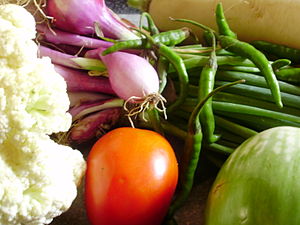You certainly didn’t need to see reports to know the price of food has risen in recent months. A trip to the supermarket is proof of the need to stretch your dollar.
It might not be as easy today as it was in the past to stretch your food dollars and offer your family healthy delicious meals. If you take time to plan your weekly menus around sale items at the grocery store and around Arizona’s in-season fruits and vegetables, it’s still possible to manage your food budget.
Did you know that you can meet the US dietary guidelines for fruits and vegetables for less than $2.50 per day? This means that for less than .50 per cup, per person, you can consume all of the fruits and veggies you need. In addition to eating healthy with Arizona fruits and vegetables as an integral part of your menu, staying away from prepared foods and fast foods will help you stay within your budget.
Planning is the best way to stretch your food dollar. If you take time at the beginning of the week to plan your breakfast, lunch and dinner menus it’s easier to stay on a budget. Make sure your budget takes snack time into consideration. When you’re thinking snacks, plan to have additional fresh fruits and vegetables on hand. Crudités (cut up fruits and veggies) are great for dipping and after school snacking and help you reach the recommended daily allowances for fruits and veggies.
Eight Tips for Staying Healthy on a Budget:
- Eat less packaged foods. Did you know it costs around $.99 for a pound of oatmeal but around $3-4 per pound for ready-to-eat cereal? Using recipes from Fill Your Plate and preparing meals from scratch is not only less expensive, it’s healthier.
- Drive past the drive-thru. Consider that it could cost up to $30 for a fast food meal for a family of four. Planning meals at home can cost as little as $10 for a family of four.
- Shop with a plan. Check grocery ads to see what is fresh and on sale. Check Fill Your Plate for recipe ideas. Build a menu by combining recipes and sale items. The list of ingredients is your grocery list. Eat before you shop to avoid impulse purchases.
- Get to know unit prices. Buying in bulk may not be the most economical or healthiest plan. Break down prices per unit to see if the bulk or smaller portion is the better deal per unit.
- Combine sales and coupons to maximize savings. Take the time to clip coupons. This could save you hundreds of dollars per year. Sign up for the grocery store reward card for additional savings and watch the ads. Diligent shoppers pay as little as zero when they combine sales, coupons and rewards.
- Buy local. Buying locally grown produce at the grocery store, a farmers market or CSA is a less expensive and healthier way to shop.
- Stock up. Stock up on your most used foods such as pasta and oatmeal when they are on sale.
- Do it yourself. Grow your own vegetables and fruits. Learn how to can your fresh produce. Compost food and have nutrient-rich soil for your garden.
Taking time to plan ahead when meal-planning and grocery shopping is the key to being healthier and staying within your food budget.
Related articles
- Rising Food Prices Part !: A Farmer’s Point of View
- How To Grow Tomatoes in Arizona
- Market Basket Update: Stretching Your Food Dollar




Pingback: You Wouldn’t Wear the Same Underwear Every Day, Would You? Reusable Shopping Bags: Sustainable, yes….but Safe? | Fill Your Plate Blog